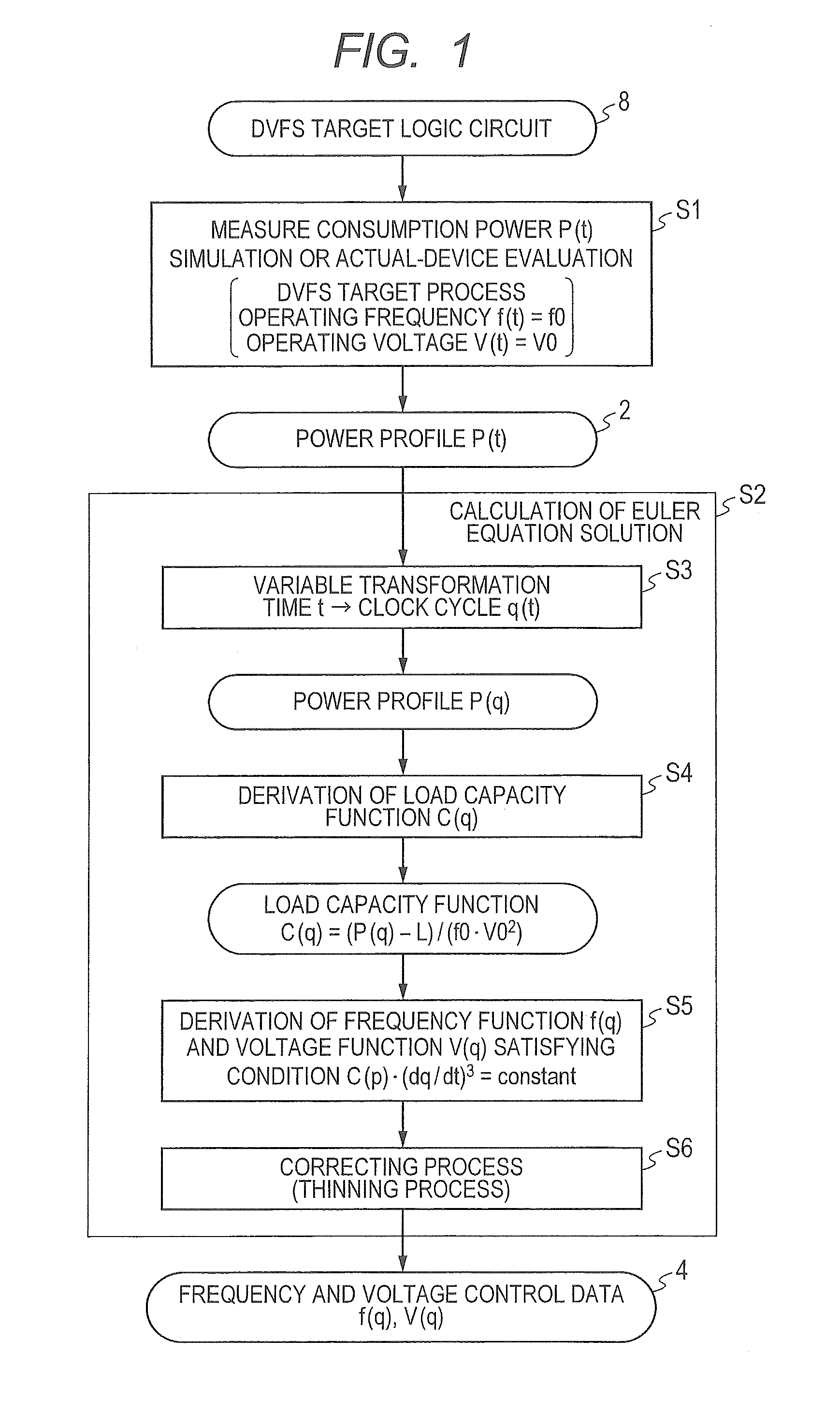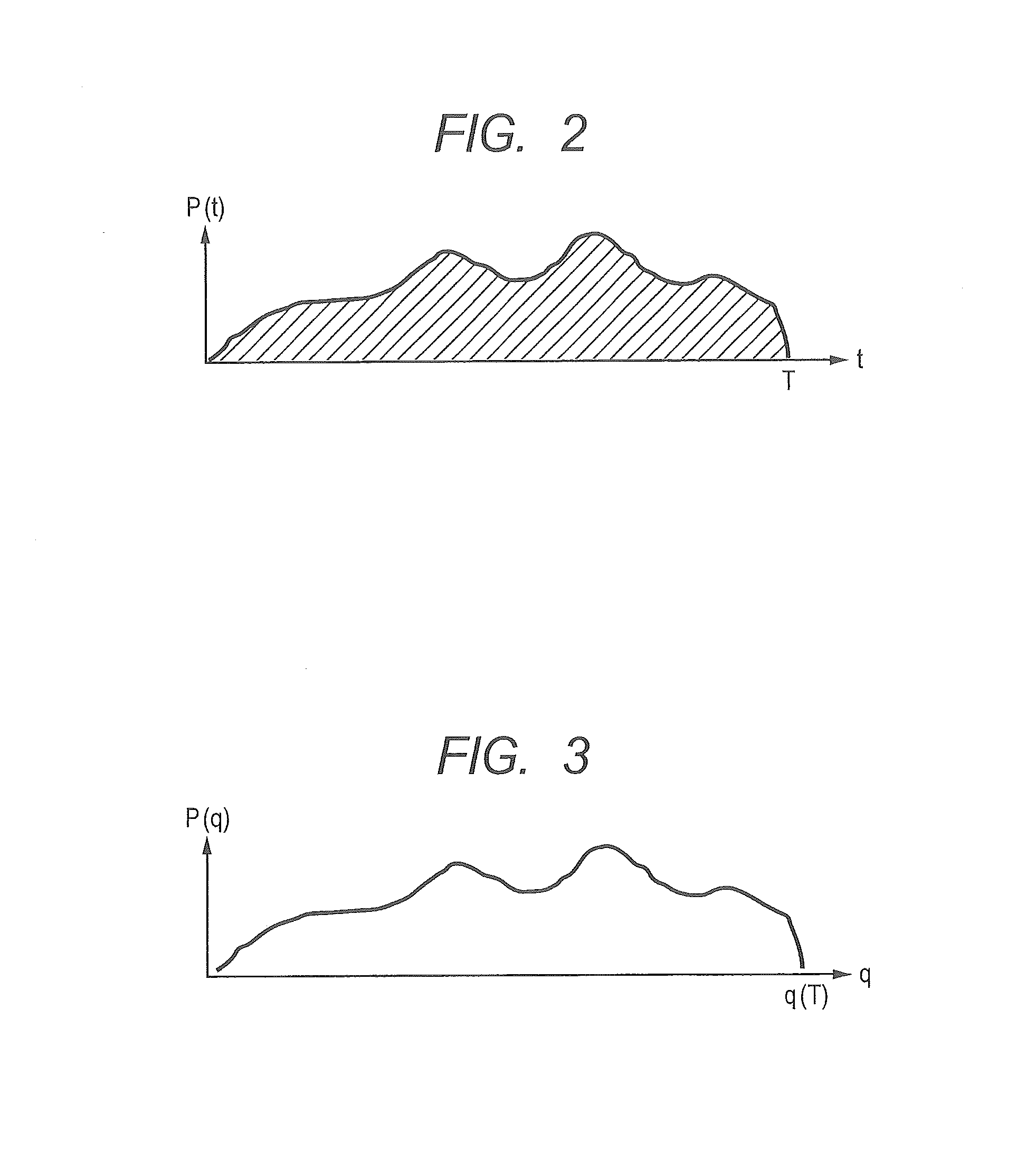Method of Designing Semiconductor Device, Designing Assistance Program, Designing Apparatus, and Semiconductor Device
a semiconductor device and assistance program technology, applied in the direction of cad circuit design, error detection/correction, instruments, etc., can solve the problem that the consumption power cannot be reduced to the real minimum consumption power, and achieve the effect of reducing consumption energy
- Summary
- Abstract
- Description
- Claims
- Application Information
AI Technical Summary
Benefits of technology
Problems solved by technology
Method used
Image
Examples
first embodiment
[0092]DVFS Control Based on Euler Equation Solution According to Calculus of Variations
[0093]The principle that an ideal DVS control in which consumption energy is theoretically minimized can be executed by the above-described representative embodiment will be described specifically.
[0094]Generally, when consumption power is expressed as P, consumption energy (power amount) is expressed as E, and time is expressed as t, the following integral equation is satisfied with respect to E.
E=∫Pdt Equation 2
[0095]FIG. 2 is a graph illustrating time fluctuations of the consumption power P when a DVFS control target circuit (logic circuit) 8 is operated at the constant frequency f in DVFS control. In the actual logic circuit 8, even in the case of performing an operation while maintaining a period of executing a target process and an operating frequency to be constant, the consumption power P fluctuates with time as illustrated in FIG. 2.
[0096]The reason why P fluctuates with time ev...
second embodiment
Processor for Including Control Data into Program
[0136]FIG. 8 is an explanatory diagram expressing an example of applying a method of designing a semiconductor device according to a second embodiment.
[0137]A semiconductor device 100 is configured by having the DVFS control target circuit 8, the DVFS control circuit 5, the clock supply circuit 6, and the power supply circuit 7. The DVFS control circuit 5 has a frequency control register 13 and a voltage control register 14. To the DVFS control target circuit 8, the clock supply circuit 6 supplies an operation clock of a frequency designated by the frequency control register 13 and the power supply circuit 7 supplies power of an operating voltage designated by the voltage control register 14. The DVFS control target circuit 8 has a processor such as a CPU (Central Processing Unit) or the like having a code memory 16 in which a program is stored, and can write data to the frequency control register 13 and the voltage control register 1...
third embodiment
Dedicated Hardware Holding Control Data in Storing Device
[0150]FIG. 13 is an explanatory diagram expressing an example of applying a method of designing a semiconductor device according to a third embodiment.
[0151]In a method of designing the semiconductor device 100 according to the third embodiment, in a manner similar to the embodiment illustrated in FIG. 7, the power profile information 2 is obtained by a simulation tool for the DVFS target circuit 8 or the actual device evaluation environment 1. At this time, a program stored in the code memory 16 is executed by the processor of the DVFS target circuit 8 at a predetermined clock frequency. Using the data of the power profile information 2 obtained, by the calculation tool 3 of the Euler equation solution, the frequency / voltage control data 4 based on the Euler equation solution is obtained. Since the operating frequency and the operating voltage optimum for each of the clock cycles are specified in the frequency / voltage control...
PUM
 Login to View More
Login to View More Abstract
Description
Claims
Application Information
 Login to View More
Login to View More - R&D
- Intellectual Property
- Life Sciences
- Materials
- Tech Scout
- Unparalleled Data Quality
- Higher Quality Content
- 60% Fewer Hallucinations
Browse by: Latest US Patents, China's latest patents, Technical Efficacy Thesaurus, Application Domain, Technology Topic, Popular Technical Reports.
© 2025 PatSnap. All rights reserved.Legal|Privacy policy|Modern Slavery Act Transparency Statement|Sitemap|About US| Contact US: help@patsnap.com



